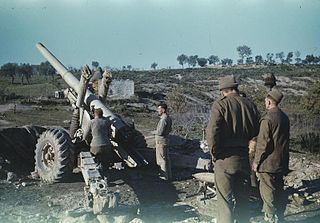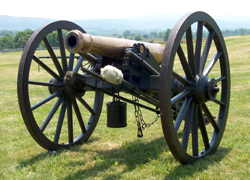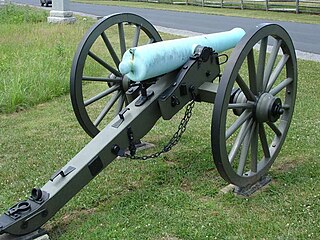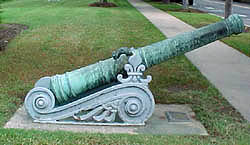
A cannon is a large-caliber gun classified as a type of artillery, and usually launches a projectile using explosive chemical propellant. Gunpowder was the primary propellant before the invention of smokeless powder during the late 19th century. Cannons vary in gauge, effective range, mobility, rate of fire, angle of fire and firepower; different forms of cannon combine and balance these attributes in varying degrees, depending on their intended use on the battlefield.

A carronade is a short, smoothbore, cast-iron cannon which was used by the Royal Navy. It was first produced by the Carron Company, an ironworks in Falkirk, Scotland, and was used from the mid-18th century to the mid-19th century. Its main function was to serve as a powerful, short-range, anti-ship and anti-crew weapon. The technology behind the carronade was greater dimensional precision, with the shot fitting more closely in the barrel thus transmitting more of the propellant charge's energy to the projectile, allowing a lighter gun using less gunpowder to be effective. Carronades were initially found to be very successful, but they eventually disappeared as naval artillery advanced, with the introduction of rifling and consequent change in the shape of the projectile, exploding shells replacing solid shot, and naval engagements being fought at longer ranges.
Infantry support guns or battalion guns are artillery weapons designed and used to increase firepower of infantry units they are intrinsic to; offering immediate tactical response to the needs of the unit's commanding officer. The designs are typically with short low velocity barrels, and light construction carriages allowing them to be more easily manoeuvred on the battlefield. They are generally used for direct fire missions, as opposed to indirect fire like other artillery units. Their role has generally been replaced by tanks using tank guns, infantry fighting vehicles using autocannons, other combat vehicles, mortars, recoilless rifles, rocket-propelled grenades and shoulder-launched missiles.

Naval artillery is artillery mounted on a warship, originally used only for naval warfare and then subsequently used for shore bombardment and anti-aircraft roles. The term generally refers to tube-launched projectile-firing weapons and excludes self-propelled projectiles such as torpedoes, rockets, and missiles and those simply dropped overboard such as depth charges and naval mines.

The BL 5.5-inch gun was a British artillery gun introduced during the middle of the Second World War to equip medium batteries.

The demi-culverin was a medium cannon similar to but slightly larger than a saker and smaller than a regular culverin developed in the late 16th century. Barrels of demi-culverins were typically about 11 feet (3.4 m) long, had a calibre of 4 inches (10 cm) and could weigh up to 3,400 pounds (1,500 kg). It required 6 pounds (2.7 kg) of black powder to fire an 8-pound (3.6 kg) round shot. The demi-culverin had an effective range of 1,800 feet (550 m).

The demi-cannon was a medium-sized cannon, similar to but slightly larger than a culverin and smaller than a regular 42 lb (19 kg) cannon, developed in the early seventeenth century. A full cannon fired a 42-pound shot, but these were discontinued in the eighteenth century as they were seen as too unwieldy. The lower tiers of eighteenth century English warships were usually equipped with demi-cannons.

A culverin was a relatively simple ancestor of the musket, and later a medieval cannon, adapted for use by the French as the "couleuvrine" in the 15th century, and later adapted for naval use by the English in the late 16th century. The culverin was used to bombard targets from a distance. The weapon had a relatively long barrel and a light construction. The culverin fired solid round shot projectiles with a high muzzle velocity, producing a relatively long range and flat trajectory. Round shot refers to the classic solid spherical cannonball.

The falconet was a light cannon developed in the late 15th century that fired a smaller shot than the similar falcon. During the Middle Ages guns were decorated with engravings of animals, such as reptiles, birds or mythical beasts depending on their size. For example, a culverin would often feature snakes, as the handles on the early cannons were often decorated to resemble serpents. The falconet fired small yet lethal shot of similar weight and size to a bird of prey, and so was decorated with a falcon. Similarly, the musket was associated with the sparrowhawk.

Naval artillery in the Age of Sail encompasses the period of roughly 1571–1862: when large, sail-powered wooden naval warships dominated the high seas, mounting a bewildering variety of different types and sizes of cannon as their main armament. By modern standards, these cannon were extremely inefficient, difficult to load, and short ranged. These characteristics, along with the handling and seamanship of the ships that mounted them, defined the environment in which the naval tactics in the Age of Sail developed.

The first usage of cannon in Great Britain was possibly in 1327, when they were used in battle by the English against the Scots. Under the Tudors, the first forts featuring cannon batteries were built, while cannon were first used by the Tudor navy. Cannon were later used during the English Civil War for both siegework and extensively on the battlefield.

The history of cannon spans several hundred years from the 12th century to modern times. The cannon first appeared in China sometime during the 12th and 13th centuries. It was most likely developed in parallel or as an evolution of an earlier gunpowder weapon called the fire lance. The result was a projectile weapon in the shape of a cylinder that fired projectiles using the explosive pressure of gunpowder. Cannon were used for warfare by the late 13th century in the Yuan dynasty and spread throughout Eurasia in the 14th century. During the Middle Ages, large and small cannon were developed for siege and field battles. The cannon replaced prior siege weapons such as the trebuchet. After the Middle Ages, most large cannon were abandoned in favor of greater numbers of lighter, more maneuverable field artillery. New defensive fortifications such as bastions and star forts were designed specifically to better withstand artillery sieges. Cannon transformed naval warfare with its deadly firepower, allowing vessels to destroy each other from long range. As rifling became more commonplace, the accuracy of cannon was significantly improved, and they became deadlier than ever, especially to infantry. In World War I, a considerable majority of all deaths were caused by cannon; they were also used widely in World War II. Most modern cannon are similar to those used in the Second World War, including autocannon—with the exception of naval guns, which are now significantly smaller in caliber.

The minion was a type of small cannon used during the Tudor period and into the late 17th century. It was of a small bore, typically 3-inch (76.2mm), and fired a 5-pound cannonball.

The BL 6-inch gun Marks II, III, IV and VI were the second and subsequent generations of British 6-inch rifled breechloading naval guns, designed by the Royal Gun Factory in the 1880s following the first 6-inch breechloader, the relatively unsuccessful BL 6-inch 80-pounder gun designed by Elswick Ordnance. They were originally designed to use the old gunpowder propellants but from the mid-1890s onwards were adapted to use the new cordite propellant. They were superseded on new warships by the QF 6-inch gun from 1891.

The 68-pounder cannon was an artillery piece designed and used by the British Armed Forces in the mid-19th century. The cannon was a smoothbore muzzle-loading gun manufactured in several weights, the most common being 95 long cwt (4,800 kg), and fired projectiles of 68 lb (31 kg). Colonel William Dundas designed the 112 cwt version in 1841 and it was cast the following year. The most common variant, weighing 95 cwt, dates from 1846. It entered service with the Royal Artillery and the Royal Navy and saw active service with both arms during the Crimean War. Over 2,000 were made and it gained a reputation as the finest smoothbore cannon ever made.
The Inventory of Henry VIII compiled in 1547 is a list of the possessions of the crown, now in the British Library as Harley MS 1419.

The 3-inch ordnance rifle, model 1861 was a wrought iron muzzle-loading rifled cannon that was adopted by the United States Army in 1861 and widely used in field artillery units during the American Civil War. It fired a 9.5 lb (4.3 kg) projectile to a distance of 1,830 yd (1,670 m) at an elevation of 5°. The 3-inch rifle was not as effective in firing canister shot as the heavier 12-pounder Napoleon, but it proved to be highly accurate at longer ranges when firing shell or shrapnel. There was only one reported case of a 3-inch ordnance rifle bursting in action. This was in stark contrast to the similarly-sized cast iron 10-pounder Parrott rifles which occasionally burst without warning, inflicting injury on the gun crews. The Confederate States of America lacked the technology to manufacture successful copies of the 3-inch ordnance rifle. However, the Confederate States Army respected the weapons and employed those captured from Federal forces.

The M1841 6-pounder field gun was a bronze smoothbore muzzle-loading cannon that was adopted by the United States Army in 1841 and used from the Mexican–American War to the American Civil War. It fired a 6.1 lb (2.8 kg) round shot up to a distance of 1,523 yd (1,393 m) at 5° elevation. It could also fire canister shot and spherical case shot. The cannon proved very effective when employed by light artillery units during the Mexican–American War. The cannon was used during the early years of the American Civil War, but it was soon outclassed by newer field guns such as the 12-pounder Napoleon. In the US Army, the 6-pounders were replaced as soon as more modern weapons became available and none were manufactured after 1862. However, the Confederate States Army continued to use the cannon for a longer period because the lesser industrial capacity of the South could not produce newer guns as fast as the North.

The 10-pounder Parrott rifle, Model 1861 was a cast iron muzzle-loading rifled cannon that was adopted by the United States Army in 1861 and often used in field artillery units during the American Civil War. Like other Parrott rifles, the gun breech was reinforced by a distinctive wrought iron reinforcing band. The gun fired a 9.5 lb (4.3 kg) projectile to a distance of 1,850 yd (1,692 m) at an elevation of 5°. The 10-pounder Parrott rifle was capable of firing shell, shrapnel shell, canister shot, or solid shot. Midway through the war, the Federal government discontinued the 2.9 in (74 mm) version in favor of a 3.0 in (76 mm) version. Despite the reinforcing band, the guns occasionally burst without warning, inflicting injury on the gun crews. The Confederate States of America manufactured a number of successful copies of the gun.

The M1857 12-pounder Napoleon or Light 12-pounder gun or 12-pounder gun-howitzer was a bronze smoothbore muzzle-loading artillery piece that was adopted by the United States Army in 1857 and extensively employed in the American Civil War. The gun was the American-manufactured version of the French canon obusier de 12 which combined the functions of both field gun and howitzer. The weapon proved to be simple to produce, reliable, and robust. It fired a 12.3 lb (5.6 kg) round shot shell a distance of 1,619 to 1,680 yd at 5° elevation. It could also fire canister shot, common shell, and spherical case shot. The 12-pounder Napoleon outclassed and soon replaced the M1841 6-pounder field gun and the M1841 12-pounder howitzer in the US Army, while replacement of these older weapons was slower in the Confederate States Army. A total of 1,157 were produced for the US Army, all but a few in the period 1861–1863. The Confederate States of America utilized captured US 12-pounder Napoleons and also manufactured about 500 during the war. The weapon was named after Napoleon III of France who helped develop the weapon.












